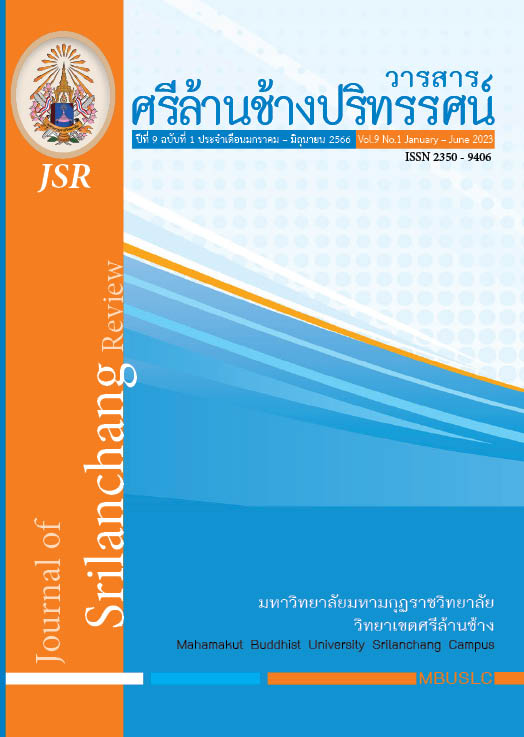การจัดการความรู้ การดำเนินการการจัดการความรู้ของมหาวิทยาลัยมหามกุฏราชวิทยาลัย วิทยาเขตศรีล้านช้าง
Main Article Content
บทคัดย่อ
บทความนี้ มีวัตถุประสงค์เพื่อ (1) ศึกษาการดำเนินการการจัดการความรู้ของมหาวิทยาลัยมหา
มกุฏราชวิทยาลัย วิทยาเขตศรีล้านช้าง (2) ศึกษาแนวทางในการพัฒนาการดำเนินการการจัดการความรู้ของมหาวิทยาลัยมหามกุฏราชวิทยาลัย วิทยาเขตศรีล้านช้าง การวิจัยเป็นการวิจัยแบบผสมผสาน 1) ข้อมูลเชิงปริมาณ ประชากรที่ใช้ในการศึกษา ได้แก่บุคลากรมหาวิทยาลัยมหามกุฏราชวิทยาลัย วิทยาเขตศรีล้านช้าง จำนวน 55 รูป/คน เครื่องมือที่ใช้ คือแบบสอบถามประมาณค่า 5 ระดับ สถิติที่ใช้ในการวิเคราะห์ข้อมูลคือค่าความถี่ ร้อยละ ค่าเฉลี่ย และส่วนเบี่ยงเบนมาตรฐาน 2) ข้อมูลเชิงคุณภาพ เก็บข้อมูลจากผู้ให้ข้อมูลสำคัญที่มีส่วนเกี่ยวข้องการจัดการความรู้ โดยใช้เครื่องมือในการสนทนากลุ่ม และทำการวิเคราะห์ข้อมูลเชิงเนื้อหา
ผลการวิจัยพบว่า
- การดำเนินการการจัดการความรู้ของมหาวิทยาลัยมหามกุฏราชวิทยาลัย วิทยาเขตศรีล้านช้าง โดยภาพรวมอยู่ในระดับมาก เมื่อพิจารณาเป็นรายด้านพบว่าอยู่ในระดับมากทุกด้าน สามารถเรียงลำดับจากมากไปหาน้อยได้ ดังนี้ ด้านการจดบันทึกแก่นความรู้ ด้านการเสาะหาความรู้ที่ต้องการ ด้านการกำหนดความรู้ที่จำเป็น ด้านการปรับปรุงและพัฒนาความรู้ให้เหมาะสม และด้านการประยุกต์ใช้ความรู้และกระบวนการแบ่งปันแลกเปลี่ยนเรียนรู้ตามลำดับ
2. แนวทางในการพัฒนาการดำเนินการการจัดการความรู้ของมหาวิทยาลัยมหามกุฏราชวิทยาลัย วิทยาเขตศรีล้านช้าง มีดังนี้ 1) การกำหนดความรู้ที่จำเป็น ได้แก่ กำหนดความรู้สู่ความเป็นเลิศขององค์กร การกำหนดความรู้ให้สอดคล้องกับแนวทางการบริหารของมหาวิทยาลัย 2) การเสาะหาความรู้ที่ต้องการ ได้แก่ การสร้างเครือข่ายวิชาการ การเชิญวิทยากรมาบรรยายให้ความรู้ 3) การปรับปรุงและพัฒนาความรู้ให้เหมาะสม ได้แก่ ส่งเสริมการวิจัยเป็นเครื่องมือการจัดการความรู้สู่การสร้างนวัตกรรม และการทำงานเป็นทีมแบบผสมผสานสายงาน 4) การประยุกต์ใช้ความรู้และกระบวนการแบ่งปันแลกเปลี่ยนเรียนรู้ ได้แก่ การประเมินผลการปฏิบัติงานจากการเข้าร่วมกิจกรรมการจัดการความรู้และความสามารถการประยุกต์ใช้ความรู้ และการนำความรู้สู่การบริการวิชาการ และ 5) การจดบันทึกแก่นความรู้ มีการนำเสนอความรู้ที่ได้ในหลายรูปแบบ
Article Details

อนุญาตภายใต้เงื่อนไข Creative Commons Attribution-NonCommercial-NoDerivatives 4.0 International License.
บทความที่ได้รับการพิจารณาจากคณะกรรมการผู้ทรงคุณวุฒิและเผยแผ่ในวารสารฉบับนี้ เป็นทัศนคติและข้อคิดเห็นส่วนบุคคลของผู้เขียนแต่ละท่าน ไม่ถือว่าเป็นทัศนะคติและความรับผิดชอบ
ของบรรณาธิการ
บทความ ข้อมูล เนื้อหา รูปภาพ ฯลฯ ที่ได้รับการตีพิมพ์ในวารสารศรีล้านช้างปริทรรศน์ ถือเป็นลิขสิทธิ์ของวารสารศรีล้านช้างปริทรรศน์ หากบุคคลหรือหน่วยงานใดต้องการนำทั้งหมดหรือส่วนหนึ่งส่วนใดไปเผยแพร่ต่อหรือเพื่อกระทำการใด ๆ จะต้องได้รับอนุญาตเป็นลายลักอักษรจากวารสารศรีล้านช้างปริทรรศน์ ก่อนเท่านั้น
เอกสารอ้างอิง
บุญชม ศรีสะอาด. (2545). การวิจัยเบื้องต้น, พิมพ์ครั้งที่ 7. กรุงเทพฯ: สุวีริยาสาส์น.
มหาวิทยาลัยมหามกุฏราชวิทยาลัย (2559). คู่มือการจัดการความรู้เบื้องต้น. นครปฐม: คณะกรรมการจัดการความรู้ มหาวิทยาลัยมหามกุฏราชวิทยาลัย
มหาวิทยาลัยมหามกุฏราชวิทยาลัย วิทยาเขตศรีล้านช้าง. (2564). แผนการจัดการความรู้ ประจำปี 2563 มหาวิทยาลัยมหามกุฏราชวิทยาลัย วิทยาเขตศรีล้านช้าง. เลย: สำนักงานวิทยาเขตศรีล้านช้าง.
ราเชนทร์ แก้วพิทักษ์. (2557). รูปแบบวัฒนธรรมองค์กรที่ส่งผลต่อการจัดการความรู้ของสถานศึกษา สังกัดสำนักงานเขตพื้นที่การศึกษามัธยมศึกษา เขต 8. ปริญญานิพนธ์ ค.ม. (การบริหารการศึกษา). นครปฐม: บัณฑิตวิทยาลัย มหาวิทยาลัยราชภัฏนครปฐม
วนิดา หมัดเบ็ญหมาน. (2562). การพัฒนาแนวทางการจัดการความรู้ของมหาวิทยาลัยหาดใหญ่ โดยใช้ KMMM. ปริญญานิพนธ์ วศ.ม. (การจัดการอุตสาหกรรม). สงขลา: บัณฑิตวิทยาลัย มหาวิทยาลัยสงขลานครินทร์
วนิดา วาดีเจริญ, รังสรรค์ เลิศในสัตย์, และสมบัติ ทีฆทรัพย์. (2560). ระเบียบวิธีวิจัยจากแนวคิดทฤษฎี
สู่ภาคปฏิบัติ. กรุงเทพฯ: บริษัท ซีเอ็ดยูเคชั่น จำกัด (มหาชน).
วรนุช สาเกผล. (2557). กลยุทธ์การพัฒนาการจัดการความรู้ของสถาบันพัฒนาครู คณาจารย์และบุคลากรทางการศึกษา (สคบศ.) เพื่อรองรับสู่ประชาคมอาเซียน. วารสารวิทยบริการ มหาวิทยาลัยสงขลา นครินทร์. 25(1). มกราคม-เมษายน 2557. 1–12.
วิจารณ์ พานิช. (2547). ความรู้ยุคใหม่ อยู่ในคนมากกว่าตำรา. กรุงเทพฯ: สานปฏิรูปการศึกษา.
สมนึก บงกชมาลี. (2548). เล่าเรื่องการจัดการความรู้ในโรงพยาบาลค่ายสมเด็จพระนเรศวรมหาราช. กรุงเทพฯ: ถักทอสายใยแห่งความรู้.
สุชาดา หวังดี. (2560). การจัดการความรู้ของครูในโรงเรียนกลุ่มศูนย์ภัทรบูรพา สังกัดสำนักงานเขตพื้นที่การศึกษาประถมศึกษาตราด. ปริญญานิพนธ์ กศ.ม. (การบริหารการศึกษา). ชลบุรี: บัณฑิตวิทยาลัย มหาวิทยาลัยบูรพา.
สุภารัตน์ ฤกษ์อรุณทอง และกุลพัทธ์ กุลชาติดิลก. (2557). ศึกษารูปแบบกระบวนการจัดการความรู้ของสถาบันการศึกษาระดับอุดมศึกษา. นครปฐม: มหาวิทยาลัยเทคโนโลยีราชมงคลรัตนโกสินทร์.
สำนักงานคณะกรรมการการอุดมศึกษา สำนักนโยบายและแผนอุดมศึกษา. (2551). กรอบแผนอุดมศึกษาระยะยาว 15 ปี ฉบับที่ 2 (พ.ศ. 2551 – 2565). กรุงเทพมหานคร: จุฬาลงกรณ์มหาวิทยาลัย.
สำนักงานคณะกรรมการการอุดมศึกษา สำนักนโยบายและแผนอุดมศึกษา. (2558). คู่มือการประกันคุณภาพการศึกษาภายใน ระดับอุดมศึกษา พ.ศ. 2557. นนทบุรี: หจก. ภาพพิมพ์.


